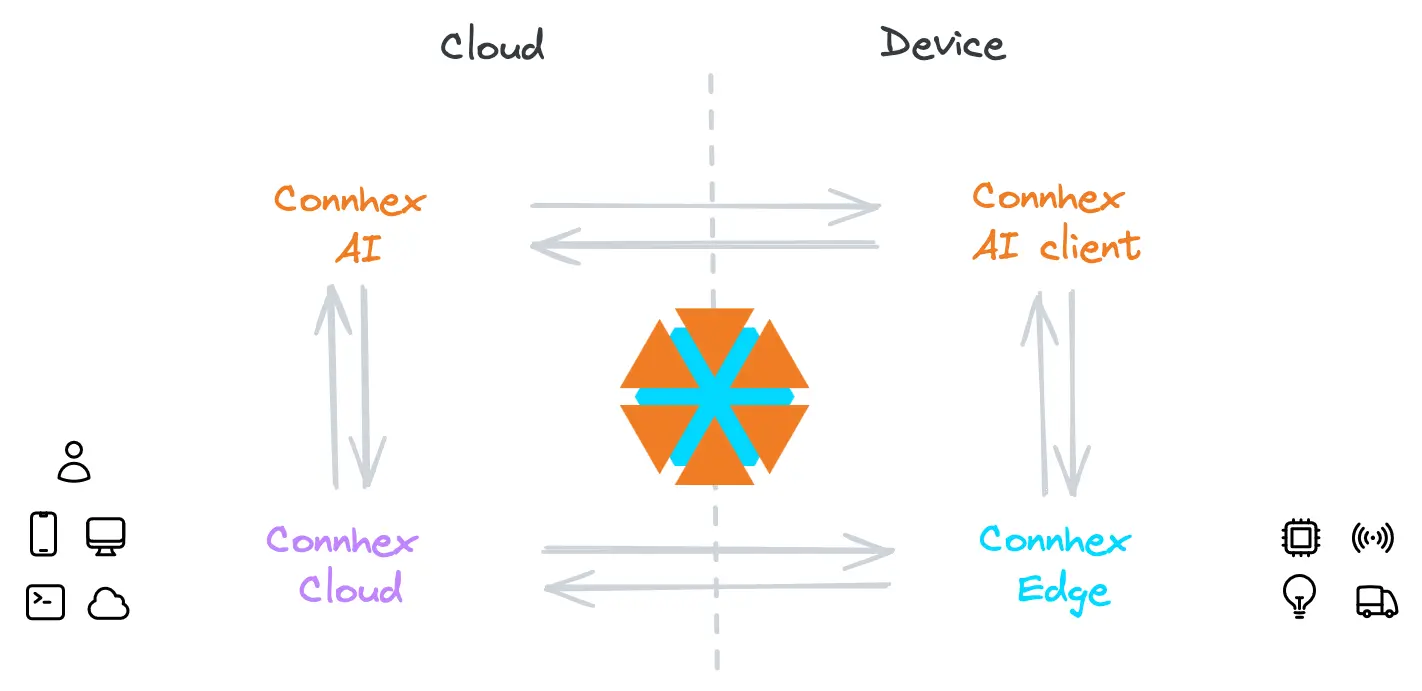Architecture overview
You can split Connhex in three main building blocks:
- Connhex Edge
- Connhex Cloud
- Connhex AI
They work best when combined, but they can also be used separately.

As the diagram above shows, two parts of the system run on the edge, while the remaining two run in the cloud. Yes, 2+2=3: that's because Connhex AI is composed of two parts.
Connhex Edge
As the name suggests, Connhex Edge is the part of the system that runs on the edge. It's a lightweight, performant and secure pool of services that can be installed on any Linux-based device. Yes, it can be used to collect data from sensors and send it to the cloud, or to control actuators and other devices: but that's what every other IoT on-device-agent does too. Connhex Edge is much more than that. It includes features that are essential in any production-grade IoT system, such as:
- it integrates with Connhex Cloud from the device production and testing phase
- it manages remote initialization and configuration of devices. It includes support for mutual TLS authentication (mTLS) with per-device X.509 certificates too: if you've ever had to deal with it, you know how painful this can be.
- it handles intermittent connectivity, so you can be sure that your devices will keep working even if they lose connection for a while. And power loss too.
- it includes tools to handle the transition period between your existing MQTT broker and your new infrastructure
- it integrates with Connhex Cloud for automated diagnostics and remote troubleshooting of devices in the field: this includes OTA updates too.
To find out more, check out the Connhex Edge section.
Connhex Cloud
Connhex Cloud is the central point of the system, where all the data is processed and stored. This includes an IIoT data collection platform, so data can be exchanged with devices using MQTT, HTTP, CoAP and WebSockets. It is easily expandable to support any other protocol you can think of. It also includes user-defined alarms, notifications, users management and cloud-to-cloud APIs.
But, once again, Connhex Cloud is dedicated to device manufacturers. That's why it includes many other features that are essential for them, like:
- it includes Connhex Control, a complete back-office system, that allows you to manage your devices and users. Think of it like the internal tool you would have to spend months developing, and never show to your customers.
- it includes a factory service that can be used to provision devices exclusively from the production line. This includes a separate security layer and a dedicated API. It also includes a remote initialization service, so that you can decouple the device production from the cloud infrastructure lifecycle.
- it includes a device diagnostics system that allows you to monitor devices and connect to them remotely, even if your firmware application is not running due to a crash or a bug.
- it features particular optimizations for large payloads (typical of legacy gateways, that periodically take a snapshot of every device connected to them even if data hasn't changed) and low running costs.
- Connhex Resources allows you to manage device registries. It can be used to create and manage device types, device models and product variations over time.
For further information, check out the Connhex Cloud section.
Connhex AI
Connhex AI is a modular machine learning system that can be used to process data from Connhex Cloud. By now, you should be getting the theme:
- it is specialized in processing data from connected devices (timeseries, events, etc.)
- it is focused on anomaly detection and forecasting. It doesn't make any assumptions on your data, so it can be used out of the box
- it is integrated with Connhex Cloud to generate actions from predictions and anomalies (notifications, alarms, etc.)
- its models automatically improve over time thanks to the feedback loop with Connhex Cloud: when enough data is available, the model is automatically retrained and updated if the performance is better than the previous one
- it is integrated with Connhex Edge to analyze data directly on device and automatically update models on the edge
For further information, check out the Connhex AI section.